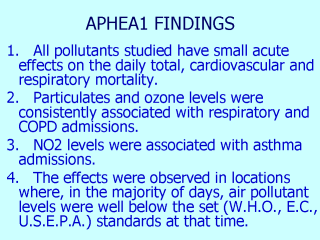 |
The APHEA project has published
an important number of articles, among them several meta-analysis on the short-term effect
of air pollution in several European cities. These studies have been very useful in the
evaluation of pollution impact in Europe and for the formulation of the air quality
guidelines. In the first phase of the study, in the meta-analysis for particulates a 0.4
per cent increase in death risk was obtained for 10 m g/m3
increase in the daily levels of PM10 and SO2, and 0.3 per cent in black smoke levels
(Katsouyanni et al., 1997) and NO2 (Touloumi et al., 1997). For PM10 and SO2 lower effects
were described in the eastern cities than in the western ones. A posterior sensitivity
analysis controlling for long term trends and season, excluding days with very high
pollution levels, reduced this heterogeneity and provided higher combined estimates
(around 0.6 and 1 per cent increase in mortality for increase in 10 m
g/m3 in black smoke and SO2, respectively). (Samoli et al., 2001). As for ozone, a 50
µg/m3 increase in ozone levels was associated with a 4 per cent increase in the number of
hospital admissions for chronic obstructive pulmonary diseases (COPD) (Anderson et al.,
1997), with a 3.5 per cent in admissions for asthma in people over 15 (Sunyer et al.,
1997) and with 2.3 per cent in the number of deaths by all causes. (Touloumi et al.,
1997). |
